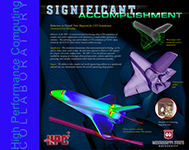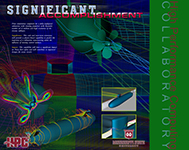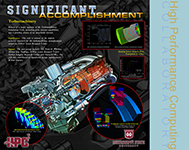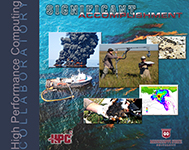Research at the HPC²
Significant Accomplishments
NASA STS-95: The John Glenn Mission
Advances in unstructured grid technologies at MSU's High Performance Computing Collaboratory (HPC2) allowed computational fluid dynamics (CFD) simulations of complex real world configurations to be obtained with a much shorter time-to-solution. During the NASA space shuttle mission STS-95 (better known as the "John Glenn mission"), a steel plate that protected the drag chute on the space shuttle was dislodged during launch. While the shuttle was in orbit, concern grew that this uncovered parachute could accidentally deploy during re-entry with unknown results and possibly even catastrophic consequences. NASA contacted MSU and requested that researchers simulate this event. The simulation, which would normally have taken months to complete, was finished within two days by HPC2 researchers, largely due to the dramatic reduction in time required through the use of unstructured grid technology developed at MSU. The HPC2's cross-disciplinary approach enabled the merging of technologies from grid generation, solution algorithms, parallel processing, and scientific visualization to make this achievement possible.
Computational Hydrodynamics
MSU researchers at the High Performance Computing Collaboratory were the first to complete flow simulations for a fully-configured submarine with a rotating propulsor with a Reynolds number of twelve million and high resolution of the viscous sublayer. The software developed for this work and its extensions provided a physics-based capability to predict the trajectory of a submarine maneuvering under the influence of moving control surfaces. This capability had significant impact on Navy fleet safety and contributed to improved designs for ocean vessels.
Turbomachinery
Researchers at MSU's High Performance Computing Collaboratory developed a turbomachinery simulation code, including fully viscous capabilities and an aeroelastic version for the NASA Lewis Research Center. This code was viewed as the de facto industry standard for turbomachinery manufacturers and researchers such as GE, Pratt & Whitney, Allison Gas Turbines, NASA Langley Research Center and the Navy's Carderock Division of the Naval Surface Warfare Center contributed to significant design improvements in new turbine engines.
Radar Power
Using the latest semiconductor, control, and switching technology, MSU developed power converters that were smaller, faster, lighter, and more efficient than any comparable systems on the market. Significant advances in silicon-carbide semiconductors coupled with increases in transistor switching speeds have resulted in dramatic overall reductions in the size and weight of components such as transformers and inductors frequently used in power electronics. As a result, the MSU Center for Advanced Vehicular Systems developed power systems that were half the volume and weight of comparable commercially available equipment, boasting both increased conversion efficiency and doubled power density.
Katrina Rescue and Recovery
In the hours immediately after Hurricane Katrina devastated the Mississippi Gulf Coast, faculty, researchers, and students from MSU's Geosystems Research Institute (GRI) suddenly became aware of the urgent, life or death situations facing the coastal residents. They realized that there was an immediate need for geo-coding locations – taking street addresses and converting them into map coordinates – providing emergency rescue personnel with longitude/latitude points to guide them to stranded storm victims. GRI's aerial imagery and mapping skills also provided valuable assistance to rescue and recovery agencies. Nearly 500 rescues, including numerous that were considered life-saving, were performed by U.S. Coast Guard rescue missions from the information provided by MSU volunteers who worked 12-hour shifts around the clock. For weeks, the group worked endlessly to provide emergency management officials with maps denoting locations of power outages, communication limitations, and supply quantities for food, water and medical provisions at relief stations throughout the state. Due to these and other efforts, MSU and GRI are now part of the State of Mississippi's official emergency response plan.
Deepwater Horizon Oil Spill Response
The Deepwater Horizon event impacted the marsh grasses in different ways at various places along the Gulf Coast. The marsh grasses are the fabric that holds the marsh together and buffers the ecosystem from tides, storms, and other impacts. The MSU Geosystems Research Institute (GRI) and Northern Gulf Institute (NGI) were able to apply their extensive remote sensing, in-situ sampling, geographic information system processing, and image analysis ability to predict where the oil would have the greatest impact on the ecosystem. As the marsh grasses became oiled, GRI and NGI were able to determine to a large extent the immediate, near-term, and long-term impact, as well as show what damage was due to the oil and what damage was due to other factors such as drought, salinity changes, and other anthropogenic impacts.






